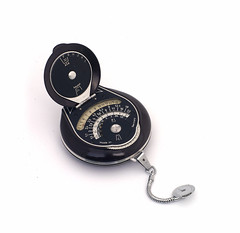Exposure meter
A light meter (short form meter) is a device that measures light to determine the proper exposure settings for a scene. Analog measuring instruments with photoelectric selenium photo cell as voltage source were the most common models of light meters for the average photographer. Later more light sensitive meters were made, with Cadmium Sulfide (CdS) photo resistors or photo semiconductors as sensors. Nowadays digital instruments dominate the market, with memory to store exposure values of flash situations by actually firing a flash just for measuring. But selenium meters are still popular since they need no battery.
Early light meters

|
| Mimosa extinction meter of 1947 |
Actinometers were the first light meters. They had the shape of a pocket watch and used light sensitive photo print paper as means of measuring. The time to darken a piece of such paper until it matches a standard tint is the input value for the scales on which an appropriate shutter-speed/aperture combination for the light situation can be found. Another type of early meters, the extinction meter, depended on eyesight: The visiblilty of a row of numbers, each behind a celluloid window of different opacity, the highest or lowest visible number determining which light situation is given.
Light meter makers

|
| Bertram Chrostar Exposure Meter |
- Gossen
- Minolta
- General Electric
- Kopil
- Lux
- Ernst&Wilhelm Bertram
- Sedic
- Sekonic
- Soligor
- Weston
- Zeiss Ikon
and many others
Light meters in cameras
Automation of exposure control in cameras began with built-in selenium meters. Shutter speed and aperture had to be selected manually according to the meter's absolute or relative measured values. With the advent of electrically controlled diaphragms and shutters other light sensors like photo resistors, photo diodes etc. became common parts in cameras. Both sorts of devices needed batteries for operation. Some additional electronic circuits combining meter with shutter and diaphragm units were just needed to get exposure control automated. This sort of camera emerged in the 1960ies.
Links
- Light meter instruction manuals www.orphancameras.com